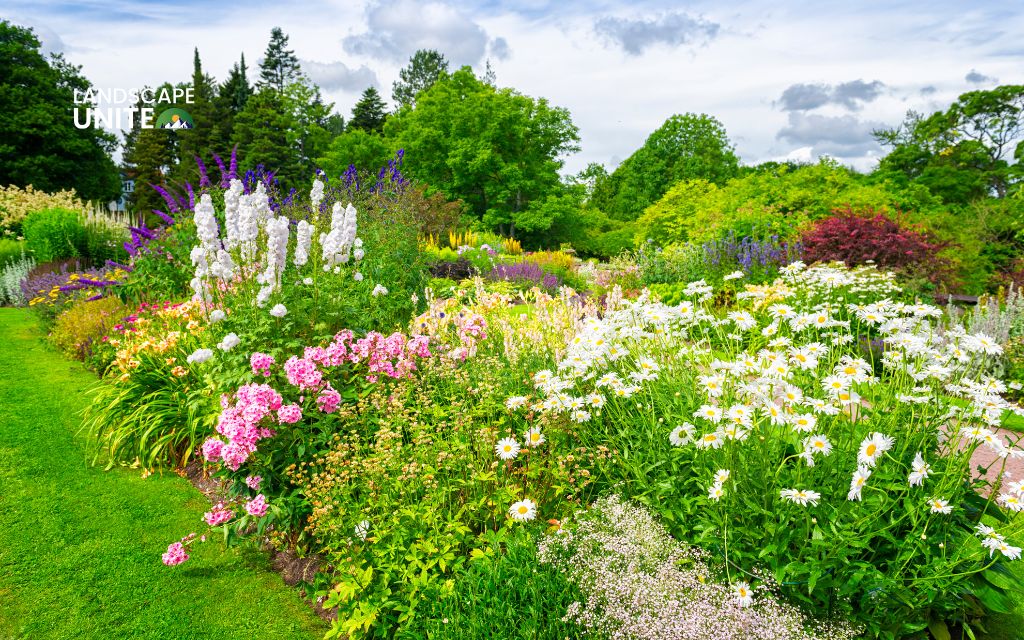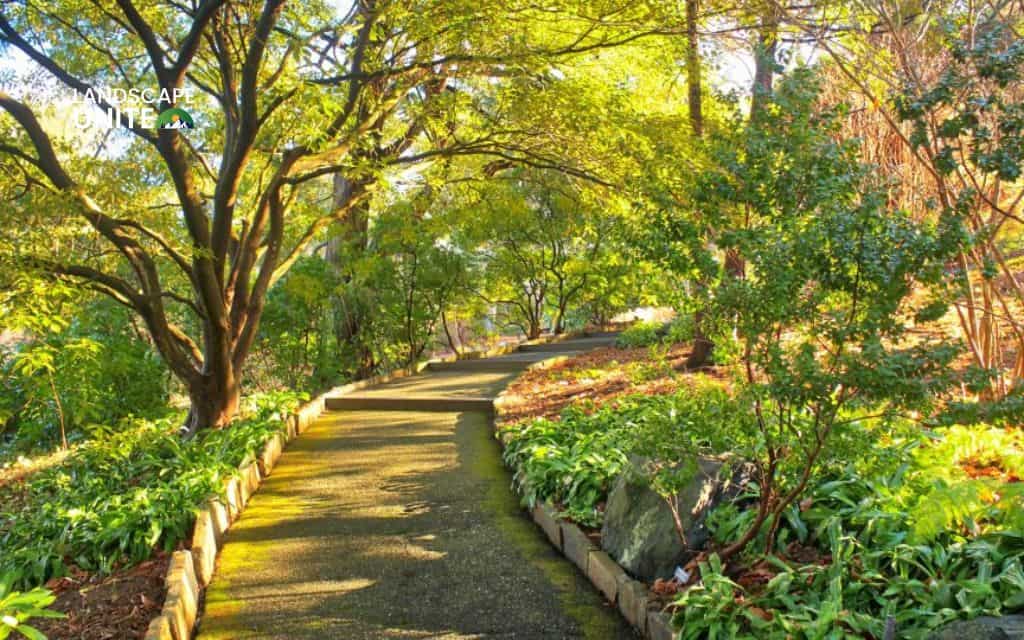Dreaming of adding a splash of color and character to your sunny yard? Sun flower beds are the answer, uniting beautiful blooms, smart design, and eco-friendly ease. Whether you’re a seasoned gardener or just starting out, this guide unpacks the secrets to lush, vibrant flower beds that shine in full sun.
You’ll learn how to choose enthusiastic sun-loving plants, layer for year-round beauty, and master fuss-free maintenance. Ready to transform that bare, sun-baked patch into a showpiece? Beautifying your living space with a spectacular sun flower bed has never been more achievable. Let’s dig in!
Why choose sun flower beds?
If your yard gets six hours or more of direct sunlight daily, you’re perfect for creating stunning sun flower beds. Here’s why they’re worth it:
Key benefits:
- Continuous color from spring through fall
- Low maintenance once established
- High curb appeal that boosts property value
- Pollinator paradise attracting bees, butterflies, and hummingbirds
- Cost-effective landscaping that pays back in beauty
Sunlight requirements:
- Minimum: 6 hours of direct sun daily
- Ideal: 8-10 hours for best blooms
- Best locations: South-facing and west-facing areas
- Watch your space throughout the day before planting
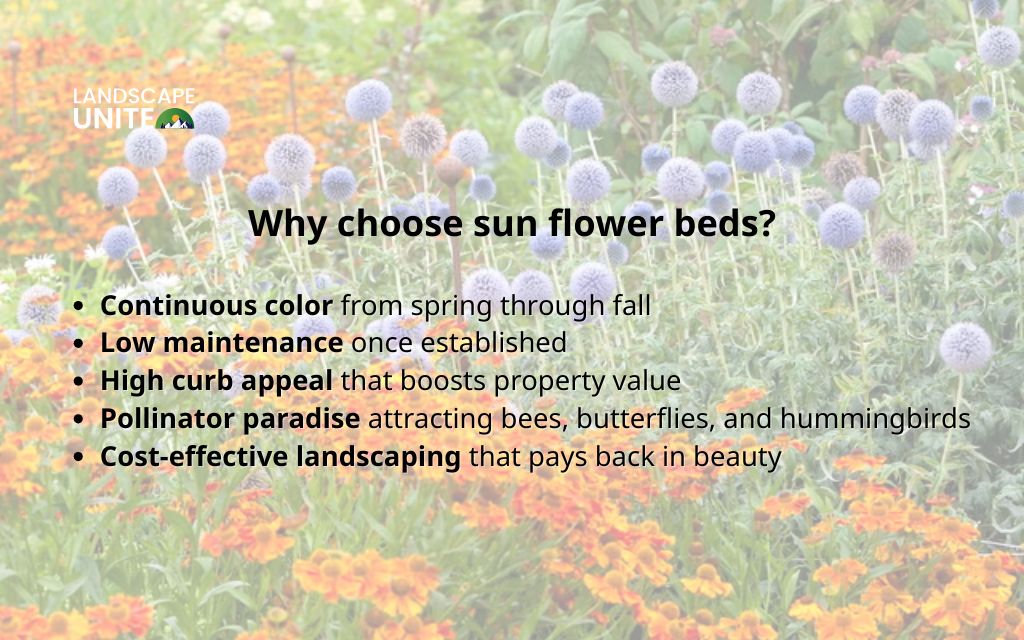
Best plants for sun flower beds
Choosing the right plants makes all the difference. Here are your top performers for flowers for flower beds full sun.
Top sun-loving annuals and perennials
Best annuals for non-stop color:
- Zinnias – Every color except blue, bloom until frost, easy from seed
- Marigolds – Bold orange/yellow/red, pest-repelling, heat-tolerant
- Petunias – Cascade beautifully, continuous bloomers, low maintenance
- Sunflowers – Dramatic height, cheerful faces, bird-friendly seeds
- Vinca – Drought-proof, spreads nicely, glossy foliage
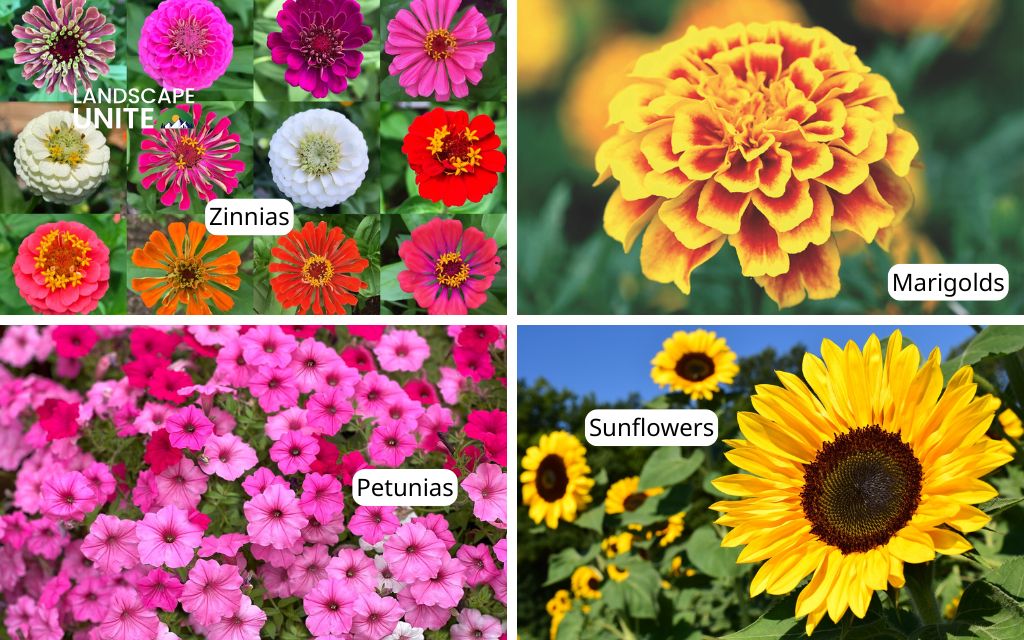
Top perennials that return yearly:
- Lavender – Fragrant, silvery foliage, drought-tolerant, pollinator magnet
- Coneflowers – Purple to orange varieties, native, extremely hardy
- Salvias – Red to purple blooms, hummingbird favorites, long flowering
- Black-eyed Susans – Golden yellow, self-seeding, carefree
- Yarrow – Flat flower clusters, drought-proof, deer-resistant
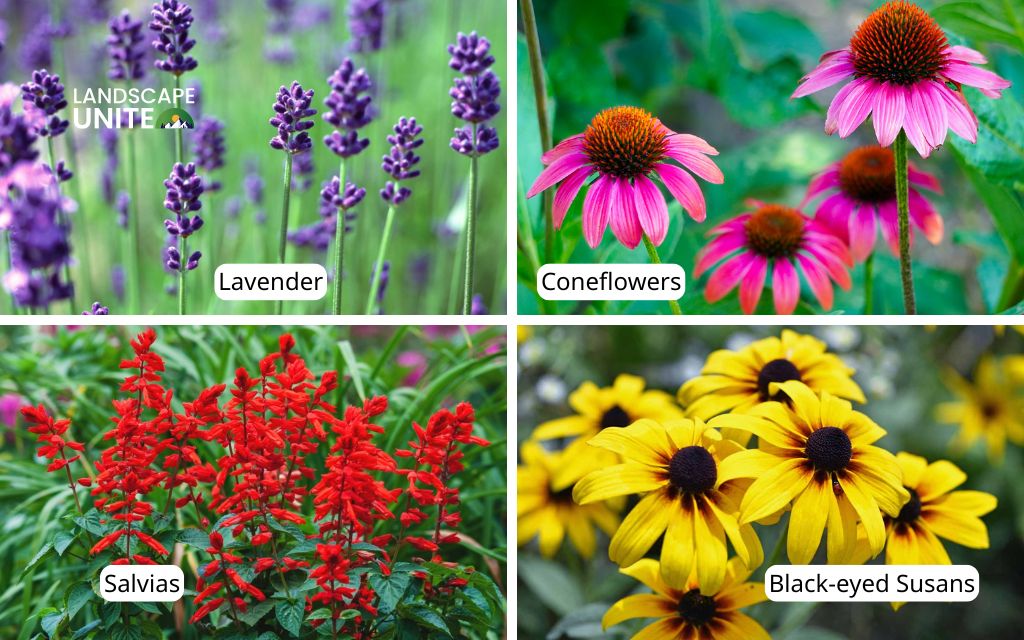
Bloom schedule for year-round interest:
| Season | Top Bloomers |
| Spring | Tulips, alliums, iris, early salvia |
| Early Summer | Peonies, coreopsis, daylilies |
| Mid-Summer | Zinnias, rudbeckia, gaillardia, echinacea |
| Late Summer/Fall | Sedums, asters, ornamental grasses, mums |
Drought-tolerant and native plant choices
Drought-tolerant stars for water-wise gardens:
- Russian sage (airy purple blooms)
- Agastache (hummingbird favorite)
- Hardy ice plant (colorful groundcover)
- Butterfly weed (monarch magnet)
- Sedum varieties (succulent foliage, late blooms)
Native plants that thrive naturally:
- Butterfly weed (brilliant orange)
- Purple coneflower (prairie classic)
- Black-eyed Susan (golden yellow)
- Prairie dropseed grass (fine texture)
- Native yarrow (white, pink, yellow)
Why choose natives?
- Adapted to your region’s conditions
- Require no special amendments
- Support local wildlife better
- Need minimal pest control
- Lower water requirements
Design inspiration: creative sun flower bed layouts
Great sun flower bed designs aren’t just about plants. They’re about smart composition that creates visual impact.
Layering for depth, texture, and visual appeal
The three-tier planting system:
Back/Center (Tall: 3-6 feet):
- Ornamental grasses
- Tall sunflowers
- Delphiniums
- Joe Pye weed
- Tall salvias
Middle Layer (Medium: 18-36 inches):
- Coneflowers
- Daylilies
- Yarrow
- Medium salvias
- Gaillardia
Front Edge (Low: 6-18 inches):
- Creeping thyme
- Compact zinnias
- Candytuft
- Sedums
- Alyssum
Texture mixing for interest:
- Fine texture: Russian sage, threadleaf coreopsis, grasses
- Bold texture: Hosta (morning sun), sedum, yucca
- Contrast: Feathery against spiky, broad leaves with narrow foliage
Pro design tips:
- Plant in odd numbers (3, 5, 7) for natural look
- Repeat key plants throughout the bed
- Use evergreen shrubs for winter structure
- Create drifts of color, not single specimens
Unique flower bed features
Raised beds advantages:
- Improved drainage
- Easier maintenance (less bending)
- Better soil control
- Instant architectural interest
- Heights: 12-24 inches work best
Creative focal points:
- Vintage wheelbarrows filled with annuals
- Weathered wooden crates stacked at angles
- Salvaged windows as trellises
- Beautiful containers as centerpieces
- Large boulders as natural anchors
- Birdbaths or garden sculptures
Edging options that pop:
- Natural stone (permanent, organic look)
- Brick laid in patterns (classic elegance)
- River rocks (naturalistic transition)
- Steel edging (modern, clean lines)
- Reclaimed wood sections (rustic charm)
Practical steps to planning and planting
Soil preparation and amendments
Quick soil prep checklist:
- Test your soil (pH 6.0-7.0 is ideal)
- Add 2-4 inches of compost to any soil type
- For clay soil: Mix in coarse sand or perlite
- For sandy soil: Add extra compost and aged manure
- Work amendments 10-12 inches deep
- Ensure proper drainage with slopes or raised beds
Best soil for sun flower beds formula:
- 40% native soil
- 40% compost
- 20% drainage material (perlite, coarse sand, or expanded shale)
Planting and maintenance tips
Planting timeline:
- Early spring: Cool-season annuals, divide perennials
- After last frost: Tender annuals (zinnias, marigolds)
- Spring or fall: Most perennials
- Fall: Spring bulbs
Step-by-step planting:
- Dig hole same depth, slightly wider than root ball
- Place plant at soil level
- Backfill with amended soil
- Water thoroughly
- Apply 2-3 inches of mulch (keep away from stems)
Maintenance schedule:
| Task | Frequency |
| Watering (new plants) | Daily for 2 weeks, then as needed |
| Watering (established) | Deep soak weekly or bi-weekly |
| Deadheading annuals | 2-3 times per week |
| Fertilizing annuals | Every 2-3 weeks |
| Fertilizing perennials | Once in spring |
| Weeding | Weekly (easier when small) |
| Mulch refresh | Annually in spring or fall |
Water-wise watering tips:
- Water early morning (reduces disease)
- Deep, infrequent better than shallow, frequent
- Use drip irrigation or soaker hoses
- Check soil 3 inches down before watering
Troubleshooting common issues
Quick pest solutions:
| Problem | Natural Solution |
| Aphids | Strong water spray, insecticidal soap |
| Spider mites | Increase humidity, neem oil |
| Japanese beetles | Hand-pick early morning into soapy water |
| Slugs | Beer traps, diatomaceous earth |
Wilting troubleshooting:
- Wilts during afternoon, recovers by evening: Normal protective response
- Persistent wilting, dry soil: Water deeply
- Persistent wilting, wet soil: Drainage problem or root rot
- During extreme heat: Temporary shade cloth helps
When to divide perennials:
Signs division is needed:
- Dead center in plant clumps
- Reduced flowering
- Crowded, congested growth
- Plants flopping over
Division timing:
- Spring bloomers: Divide in fall
- Fall bloomers: Divide in spring
- Every 3-5 years for most perennials
Checklist seasonal flower bed care for year-round beauty
Great sun flower beds look intentional twelve months a year. This maintenance calendar helps you stay ahead of tasks so your landscape always shines.

Spring (March-May):
- ☐ Remove winter mulch from perennial crowns
- ☐ Cut back dead stalks
- ☐ Apply compost and fertilizer
- ☐ Divide crowded perennials
- ☐ Edge beds and refresh mulch
- ☐ Plant after last frost date
Summer (June-August):
- ☐ Water deeply during dry spells
- ☐ Deadhead regularly
- ☐ Stake tall plants
- ☐ Watch for pests
- ☐ Keep up with weeding
- ☐ Take notes on what works
Fall (September-November):
- ☐ Plant spring bulbs
- ☐ Divide spring-blooming perennials
- ☐ Continue deadheading until frost
- ☐ Cut back or leave perennials for winter interest
- ☐ Apply mulch after ground freezes
Winter (December-February):
- ☐ Review photos and plan improvements
- ☐ Browse catalogs for new varieties
- ☐ Sketch design changes
- ☐ Order seeds early
- ☐ Leave seed heads for birds
FAQs about sun flower beds
What are the best flowers for a full sun flower bed?
Top annuals: zinnias, marigolds, petunias, sunflowers. Top perennials: lavender, coneflowers, salvias, black-eyed Susans, yarrow. These handle 6+ hours of direct sun with minimal care. For detailed plant recommendations, explore more guides on the Landscape Unite blog.
How do I keep my sun flower bed blooming all summer?
Choose plants with different bloom times, deadhead regularly, water during dry spells, and fertilize annuals every 2-3 weeks. Succession planting fills gaps mid-season. For custom bloom schedules, contact Mile High Lifescape for professional design.
Can I create a sun flower bed in a small yard?
Yes! Use compact varieties, grow vertically with trellises, mix containers with in-ground plantings, and choose long-blooming plants. Raised beds maximize space in tiny yards.
What soil is best for sun-loving flowers?
Well-draining soil enriched with compost, pH 6.0-7.0. Amend clay with compost and coarse sand. Improve sandy soil with extra compost for moisture retention.
How do I make my sun flower bed low-maintenance?
Choose drought-tolerant perennials, install drip irrigation, apply thick mulch, select long-blooming plants, and use native species. Group plants by water needs. For truly hands-off gardens, reach out to Mile High Lifescape or explore low-maintenance tips on our blog.
Conclusion
Creating stunning sun flower beds transforms ordinary yards into vibrant outdoor retreats that celebrate color, texture, and life. You now have the knowledge to choose perfect sun-loving plants, design captivating layouts, and maintain beds that bloom brilliantly season after season. Whether you’re starting small or reimagining your entire front yard landscaping, these strategies work for gardeners at every skill level.
Ready to get started? Take action this weekend by assessing your sunny spaces and sketching your dream design. Plant those first sun flower beds and watch your outdoor space transform. Landscape Unite is your trusted resource for all things gardening and landscape, offering expert tips, creative inspiration, and practical guidance for every project.
Contact Landscape Unite today for more great tips and discover new posts on our blog that help you create the outdoor living space you’ve always wanted!

